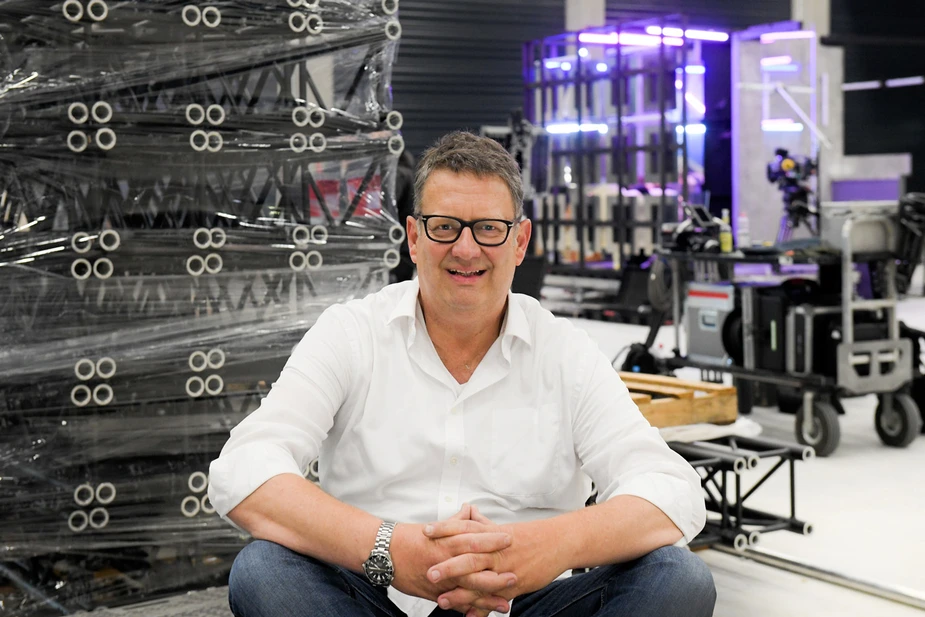“Building this studio was a dream of mine”
One of Europe’s largest XR (extended reality) studios is being created in Adlershof’s Science City
Head lighting technician Mike Zimmermann and his company Lichthaus Berlin GmbH are pioneers of environmentally friendly movie production. Productions at the new studio in Adlershof are 100 percent sustainable.
Sustainable film production is a trend. Not only public broadcasting agencies are developing guidelines for more sustainable production, the Konrad Wolf Film University of Babelsberg too published a “Green Guide” and festivals like Berlinale and Cannes are optimising their carbon footprint. The economy as a whole is on the move. Despite the high costs of green production, accrued through new equipment and higher costs of travel, the Energiewende is palpable.
Mike Zimmermann, CEO of the Lichthaus Group, a film technology specialist, has been working to make his business more green for ten years. He started by buying digital cameras for his 70-strong team and later began replacing lamps with LEDs and putting filters on diesel generators. “95 percent of our fleet is being completely filtered. This is not an industry regulation, we just think it’s the right thing to do,” explains Zimmermann.
The headquarters of LHB Lichthaus Berlin GmbH covers an area of 7,500 m² and is made up of a light hall, a studio, and a production house, which has an entire floor made of glass. One of the roofs, this is city regulation, is green to improve sound and heat insulation, the other is equipped with photovoltaics. Covering 1,100 m², the large solar system produces enough electricity to power the entire building all day. At night, the company uses green electricity and the district heating system. “By doing so, our entire production is done sustainably and locally.” Staff who own an electric vehicle can recharge them at a station with four double chargers.
For Zimmermann, a father himself, “green building” is a matter of course. “It was important to me to make our new building as sustainable as possible. In a few years, we will be passing the baton to our children and we should be make sure to live in a more environmentally friendly way.” In practice this means the use of less plastic, less air travel, less deliveries with car and vans, and more recycled materials for props. “Using backlot sets, or producing everything in a studio, are viable alternatives,” he suggests. “People used to travel to Africa with a giant entourage, now a lot of things are done digitally.”
One of Europe’s largest XR studios is scheduled to open here in August. XR stands for extended reality and deals with technological means to connect the physical and the digital realm. LED modules and 360-degree video walls will cover an area larger than 800 m². The Berlin-based studio has a diameter of 24 metres, is 7.5 metres high, and a total floor space of 4,000 m². Two thirds of the ceiling is covered with panels.
According to Zimmermann, there are now downsides to digital production: “Your creativity can run free. Thanks to virtual backdrops, the director can see first-hand if the result are good. Post-production is less costly and less risky for the producer.” Mike and his team are currently having a eight by four metre swimming pool built for shooting the series “You”.
Historically, this is not the first time that a large pool of water was in this exact place. The Lichthaus Group premises is located in the immediate vicinity to those of the former Johannisthaler Filmanstalten (Jofa), East Berlin’s dream factory. It’s where Herbert Selpin shot the sinking of the “Titanic” (1943) and where F. W. Murnau’s made “Nosferatu” (1922).
A life’s dream come true for the 52-year-old. He grew up in Johannisthal; his mother was responsible for procuring equipment for DEFA-Synchron, located on the Jofa premises. At the age of eight, Zimmermann used to roam the area, peeking into the studios, and having lunch with the actors. He later did an apprenticeship as a high voltage technician at Berlin’s S-Bahn and then, following his mother’s advice, applied for a job as a lighting technician at Jofa.
Returning to his roots like this is the best thing in the world for Zimmermann: “With all this powerful history in mind, I was driven to move back here. Building this studio was a dream of mine and it is nice to have so many people believe in my dream.”
By Susanne Gietl for Adlershof Journal
